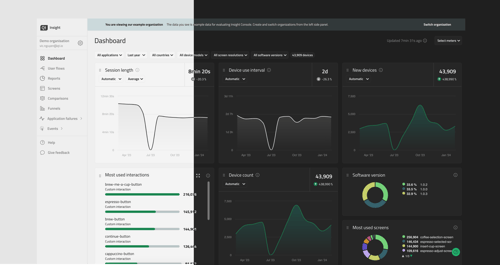User-Centricity and Analytics for Enhanced Healthcare Outcomes
September 20, 2024 by Nghi Dang | Comments
As healthcare technology evolves, medical devices' functionality and innovative features will remain paramount. However, the gateway to access these features effectively is through a well-designed UX/UI (user experience/user interface). Regulatory bodies worldwide have increasingly recognized the impact of these elements on the proper use and efficacy of medical devices. For instance, regulatory frameworks and guidelines, including IEC 62366-1 and directives from the European Medical Device Regulation (MDR) and the US Food and Drug Administration (FDA), now emphasize the importance of designing with user needs in mind in the development process.
This shift toward more intuitive and user-friendly devices was also highlighted in the Visionary Voices of Tech webinar "Revolutionizing Healthcare: The Future of Intuitive Medical Devices." A prime example is the portable handheld ultrasound devices developed by Clarius, which meet the modern demand for smartphone-like interfaces, portability, and convenience, marking an innovative transformation in the industry.
Enhancing Medical Device User Interface Design With Analytics
The key to developing intuitive UIs is ensuring they are both functional and easy to understand, which are crucial for user adoption. Often, users lack awareness of all the features that software has to offer, causing them to miss out on valuable functionalities. Hidden or buried features remain unused. Only relevant features are adopted if they align with users' tasks and goals. Users also wish to provide feedback on their user experiences, and new users require an efficient onboarding process. User-centric development is, therefore, as essential as ever and particularly critical in the medical industry, as poor user adoption can result in mental load and emotional distress for healthcare professionals, ultimately affecting patient care.
Furthermore, the demand for remote care, personalized healthcare, and connected medical devices has increased significantly post-COVID, leading to a more diverse user base, including not just professionals but also patients and their family members. This emphasizes the need to create more adaptable and accommodating designs for a broader range of users. Real-world user data can guide intuitive design and iterative UX/UI improvements.
Creating and delivering successful software or products, overall, requires aligning feature development with customer needs. Analytics based on the data collected on a product's or device's usage and performance can enable developers, designers, and product managers to make informed decisions on how best to optimize user experience. Further, analytics-driven insights help align test cases with user behavior and identify vulnerable areas where test coverage can be enhanced.
Specifically for the medical industry, data on device usage, responsiveness, and functionality is crucial for post-market surveillance of medical devices. According to the US National Institute of Health, clinical trials are the primary method for determining if a new treatment or device is safe and effective for end users. Clinical trials include three stages. The first two stages involve the pilot stage, which determines if the device works, and the pivotal stage, which assesses if the device is safe and effective. Post-market surveillance–the third stage–aims to uncover any information about the safety and effectiveness of the medical devices that the first two stages of the clinical trials did not reveal. Medical device manufacturers must meet the surveillance requirements to comply with 21 CFR Part 820 and ISO 13485.
Leveraging Analytic Insight for Medical Device Functionality and Usability
Qt Insight, Qt Group's cloud-based analytics tool specifically designed to offer insights on application or device usage, is highly relevant to addressing the above needs, notably meeting the data needs of post-market surveillance for medical devices. Six primary sources of post-market data include post-market clinical studies, literature reviews, customer cases, customer surveys, expert user groups, and service reports. Qt Insight can complement service reports by furnishing additional information about the aging process of the device and any operational issues encountered in the field. Additionally, by monitoring medical devices in the field, manufacturers can proactively address end-user issues before they escalate. With historical data, Qt Insight can predict future behavior, identify potential customer pain points, and provide actionable insights based on analytics. User flows within Qt Insight also facilitate the identification of popular routes, detection of usability issues, and analysis of flow to enhance the user experience.
The Qt Insight dashboard also displays the top features, peak usage, and application usage across various metrics, such as geographical distribution. It is customizable and offers insights into the most used interactions, UI views usage and drop-off rates. This aids in analyzing feature adoption and identifying areas for improvement or better integration into clinical workflows. In addition, understanding the user interface paths for anomalies, UI updates, and comparisons before and after releases will guide one on where to make medical devices more intuitive.
With Qt Insight, stakeholders can make data-informed decisions on improving medical devices' usability and effectiveness. The tool can also help with field testing optimization and onboarding optimization. The latter is vital since a smooth first-use experience can increase adoption rates and ensure the device is used to its full potential. Qt Insight further distinguishes itself by facilitating easy integration with Qt applications, ensuring customer full data ownership, and meeting the analytics needs specific to Qt-based software development.
👉 Learn more about Qt Insight.
Blog Topics:
Comments
Subscribe to our newsletter
Subscribe Newsletter
Try Qt 6.8 Now!
Download the latest release here: www.qt.io/download.
Qt 6.8 release focuses on technology trends like spatial computing & XR, complex data visualization in 2D & 3D, and ARM-based development for desktop.
We're Hiring
Check out all our open positions here and follow us on Instagram to see what it's like to be #QtPeople.
.webp)




